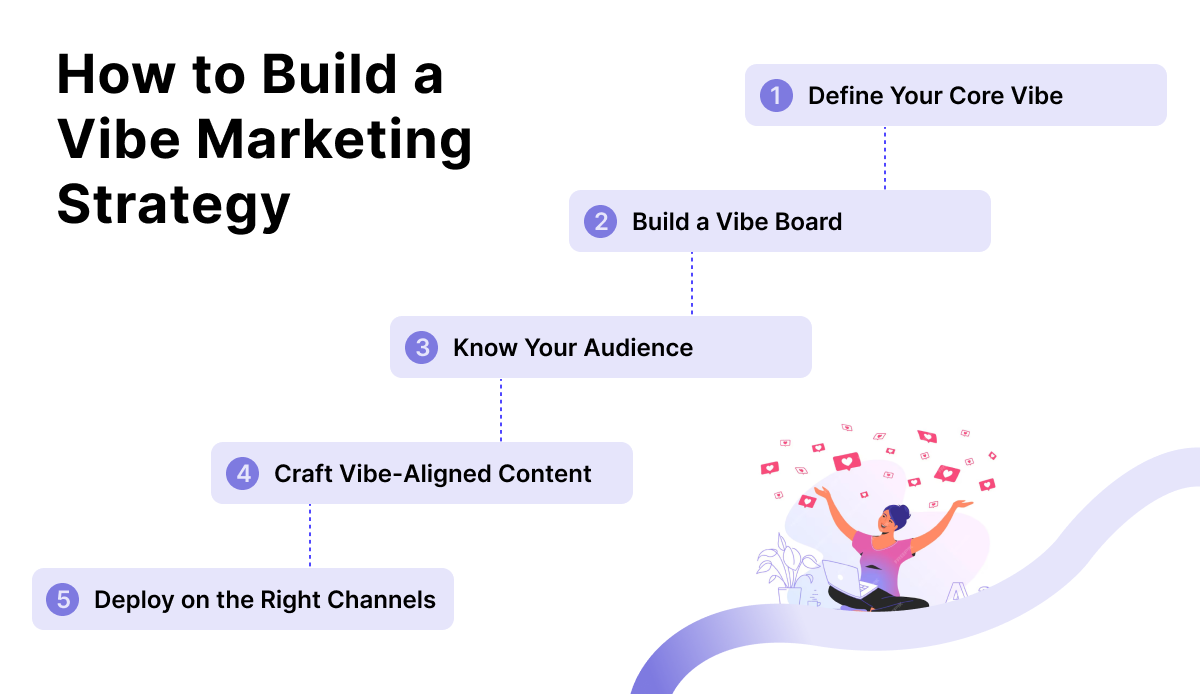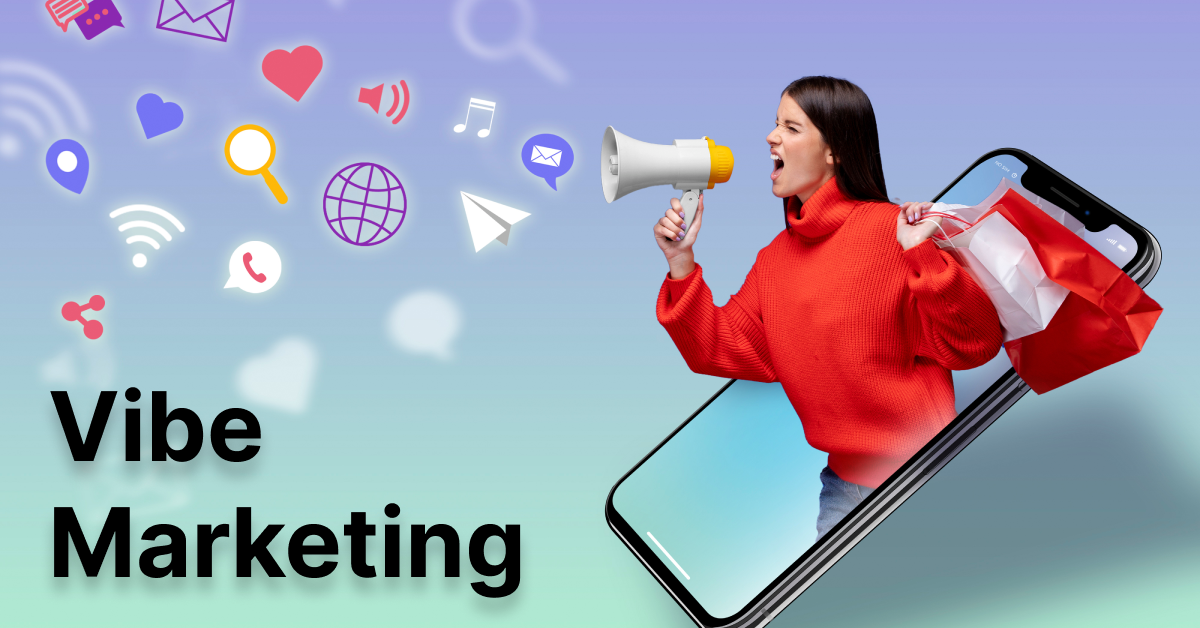Vibe Marketing is more than a trend—it’s a seismic shift in how brands connect with modern audiences. In 2025, attention is fleeting, digital noise is louder than ever, and consumer expectations are higher. Enter Vibe Marketing, a strategy that aligns brand messages with the emotional, aesthetic, and cultural “vibes” that resonate with audiences.
In this comprehensive guide, we’ll break down what Vibe Marketing is, why it matters in 2025, and how your brand can adopt it effectively. From examples to strategies, this post will show you how to leverage the power of vibes to build real connections and lasting brand loyalty.
1. What Is Vibe Marketing?
Vibe Marketing is a branding strategy that prioritizes emotional resonance over traditional promotion. It’s all about crafting a feeling, mood, or atmosphere that aligns with your audience’s values, aesthetics, and cultural context. Instead of selling a product, you’re selling an experience—something people want to be part of.
In contrast to direct response marketing or informational campaigns, Vibe Marketing taps into deeper psychological desires. It’s less “Buy this now!” and more “This is who we are—do you vibe with us?”
By 2025, consumers are making purchase decisions based on alignment with personal identity, values, and aesthetics. Vibe Marketing offers the perfect framework for this evolved behavior.
2. The Psychology Behind Vibe Marketing
At its core, Vibe Marketing leverages the human need for emotional connection and identity affirmation. In a fragmented digital world, people are drawn to brands that reflect their values, aspirations, and mood.
Why it resonates:
- Neuropsychology shows that people make decisions emotionally first and rationalize them later.
- Social Identity Theory proves that individuals gravitate toward groups (and brands) that reflect who they are.
- Aesthetic fluency increases trust—when people like the vibe, they trust the brand.
By understanding how aesthetics, tone, and messaging affect emotions, brands using Vibe Marketing in 2025 are tapping into real, sustainable engagement.
3. Why Vibe Marketing Works in 2025
In 2025, attention is a scarce resource, and consumer skepticism is at an all-time high. Traditional tactics are losing effectiveness. Here’s why Vibe Marketing works so well now:
1. Gen Z and Millennials Demand Authenticity
Younger audiences crave brands that are real, not polished facades. Vibe Marketing leans into imperfect, raw, and relatable content.
2. Short-Form Content Reigns
TikTok, Instagram Reels, and YouTube Shorts dominate. Vibe-driven content performs better in these formats because it’s more experiential than instructional.
3. Community > Commodity
People want to belong. Vibe Marketing invites consumers to join a tribe rather than just buy a product.
4. Cultural Fluidity
Culture shifts fast. Brands that can reflect the mood of the moment—or the meme of the week—win big. Vibe Marketing allows for adaptive messaging.
4. Key Elements of a Vibe Marketing Campaign
To successfully implement Vibe Marketing, your campaign needs to align across several emotional and aesthetic touchpoints:
1. Tone of Voice
Your brand’s tone should feel natural, intimate, and emotionally intelligent.
2. Visual Identity
Use color palettes, lighting styles, and filters that evoke a specific mood—nostalgia, minimalism, coziness, rebellion, etc.
3. Soundtrack & Music
Audio is powerful. Lo-fi beats, retro synths, or upbeat indie pop can set the tone of a reel or ad better than words.
4. Cultural References
From TikTok trends to fashion statements to political sentiments, referencing the cultural moment deepens relevance.
5. Storytelling > Selling
Use narrative structures, real people, and aspirational journeys instead of direct calls to action.
By embedding these elements, your Vibe Marketing efforts will feel intentional rather than opportunistic.
5. How to Build a Vibe Marketing Strategy
Follow this step-by-step guide to create your own Vibe Marketing strategy in 2025:

Step 1: Define Your Core Vibe
Identify the emotional tone your brand wants to evoke: Is it chill? Bold? Empowering? Nostalgic? This becomes your compass.
Step 2: Build a Vibe Board
Similar to a mood board, curate visuals, phrases, music, and styles that reflect your brand’s vibe. Use Pinterest, Notion, or Figma.
Step 3: Know Your Audience’s Emotional Language
Use social listening tools to understand how your target market expresses themselves—emojis, slang, tone.
Step 4: Craft Vibe-Aligned Content
Create short-form videos, aesthetic images, and captions that amplify your vibe. Less focus on product features, more on feel.
Step 5: Deploy Across Relevant Channels
Don’t try to force Vibe Marketing into LinkedIn if your brand’s vibe is playful. Focus on platforms where the culture fits—like TikTok, Instagram, or even Threads.
6. Tools & Platforms for Vibe Marketing Success
To streamline and amplify your Vibe Marketing strategy, these tools are essential:
| Tool | Purpose |
| Canva Pro | Aesthetic templates, social media designs |
| CapCut | Edit reels and TikToks with trending audio |
| Later | Plan and schedule vibe-aligned content |
| BuzzSumo | Track cultural trends and viral topics |
| Notion | Build vibe boards and strategy docs collaboratively |
Having the right tech stack makes it easier to keep your visuals, tone, and timing on point.
7. Real-World Examples of Vibe Marketing
Successful brands in 2025 are no longer just selling products—they’re selling experiences, emotions, and identities. Below are standout examples of Vibe Marketing done right, where the brand doesn’t simply market—it creates a cultural vibe that resonates deeply with its audience.
- Glossier: Glossier pioneered the “effortlessly beautiful” aesthetic. Their clean, pastel-toned visuals, natural-looking models, and relatable captions quietly affirm the message: “You’re already beautiful—just enhance your vibe.” Instead of pushing hard sells, Glossier creates a digital space where customers feel seen, comfortable, and part of a like-minded community. Their vibe? Soft, empowering, and subtly inclusive.
- Duolingo on TikTok: What started as a language learning app exploded into a TikTok sensation thanks to its self-aware, meme-filled content featuring its owl mascot. By embracing chaos, humor, and Gen Z irony, Duolingo turned corporate content into viral entertainment. The result? Massive increases in brand awareness, app downloads, and user engagement—all without traditional advertising. Their vibe? Quirky, fearless, and culturally fluent.
- A24 Films: A24 doesn’t just promote its films—they curate an aesthetic experience. Their trailers, posters, and social content feel more like indie art installations than movie promos. Whether it’s minimalist horror, dreamy nostalgia, or existential drama, A24 creates distinct emotional worlds that viewers want to be immersed in. Their vibe? Artsy, enigmatic, and visually captivating.
- Liquid Death: Selling canned water might sound boring—until you brand it like a heavy metal revolution. Liquid Death wraps hydration in punk rebellion, complete with edgy fonts, skulls, and “murder your thirst” slogans. It’s not just a drink—it’s a lifestyle statement for those tired of sterile wellness branding. Their vibe? Bold, irreverent, and anti-establishment.
These brands excel at Vibe Marketing because they go beyond product features. They create emotional, cultural, and aesthetic touchpoints that invite customers into a shared identity. The result? Not just brand awareness, but brand obsession.
8. Common Mistakes to Avoid
While Vibe Marketing can be a powerful tool for connection and growth, it’s easy to miss the mark if your strategy isn’t intentional. Below are some of the most common missteps brands make—and how to avoid them:
- Being Inauthentic: One of the biggest pitfalls in Vibe Marketing is trying to force a persona or aesthetic that doesn’t align with your brand’s core identity. Audiences in 2025 are highly attuned to authenticity. If your content feels forced, performative, or like you’re pandering to a trend, it can erode trust quickly. Instead, stay true to your voice and values—even if that means not participating in every viral trend.
- Over-Aestheticizing Without Substance: It’s easy to get caught up in creating beautiful visuals and perfectly curated content—but if your brand message gets lost in the aesthetic, you risk coming across as superficial. A pretty feed without meaning won’t build lasting connections. Balance visual appeal with substance by pairing compelling imagery with honest storytelling or value-driven messaging.
- Ignoring the Data: Although Vibe Marketing is rooted in emotional resonance, that doesn’t mean you should abandon analytics. Without measuring the performance of your content—such as engagement rates, conversions, or reach—you’ll have no idea if your strategy is actually working. Make space for creativity, but always back it up with A/B testing, social listening, and user feedback to refine your approach.
- Misreading or Hijacking Cultural Moments: Attempting to align your brand with social causes, cultural trends, or generational movements can be powerful—but only when done with authenticity and care. If your campaign seems opportunistic or tone-deaf, it can backfire and alienate your audience. Before jumping in, ask yourself: Does this message truly reflect our brand’s mission? Are we adding value or simply trying to capitalize on attention?
By steering clear of these common mistakes, your Vibe Marketing efforts will come across as more genuine, impactful, and sustainable-earning you not just likes, but loyalty.
9. Measuring Vibe Marketing ROI
Though vibe is intangible, its impact isn’t. Here’s how to measure Vibe Marketing results:
- Engagement Rate (likes, comments, shares)
- Brand Sentiment (via social listening tools)
- Customer Retention (vibe builds loyalty)
- User-Generated Content (the ultimate sign of emotional alignment)
- Organic Reach Growth (vibe attracts new fans without paid media)
Track these alongside traditional metrics to evaluate how well your vibe lands.
10. Final Thoughts
In 2025, Vibe Marketing is no longer optional—it’s essential. The brands that win attention, loyalty, and love are those that speak the emotional language of their audience. Vibe Marketing allows you to show up not just as a vendor but as a vibe—a cultural entity worth engaging with. By understanding your audience’s mood, aesthetic preferences, and emotional needs, your brand can position itself as a vibe leader—not just another advertiser. If you want to resonate deeply and stand out in a cluttered market, start building your vibe now.
FAQs on Vibe Marketing
Vibe Marketing is a strategy focused on aligning brand messaging with emotional tones, aesthetics, and cultural moods to build deeper connections with audiences.
In 2025, audiences seek authenticity, emotional resonance, and cultural relevance. Vibe Marketing meets these needs better than traditional methods.
Traditional marketing emphasizes features and benefits; Vibe Marketing prioritizes mood, emotion, and alignment with audience identity.
Absolutely. Small brands often have more flexibility to authentically engage with trends and create intimate content experiences.
Instagram, TikTok, YouTube Shorts, and Threads are ideal platforms for vibe-driven content due to their visual and short-form nature.
Start by identifying the emotions you want to evoke, building a vibe board, and testing content styles that align with your brand values.
Yes, by building emotional trust and community, Vibe Marketing can lead to higher conversion and retention over time.
Fashion, beauty, wellness, lifestyle, entertainment, and tech brands all see strong results from vibe-led strategies.
Track metrics like engagement rate, brand sentiment, organic reach, and customer loyalty to gauge performance.
Yes, AI tools like content generators, trend trackers, and analytics platforms can help refine and scale your Vibe Marketing approach.
